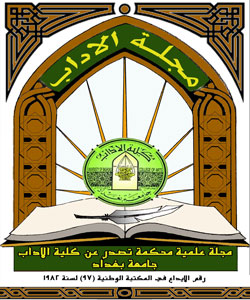دور الاستعارة الإدراکیة في تکوین المنظومة الإیدیولوجیة العلویة وعرضها في نهجالبلاغة
تحلیل الاستعارات التصورية «الدنيا شيء زهید مثیر للاشمئزاز وللتقزز» نموذجا
DOI:
https://doi.org/10.31973/aj.v1i147.4128الكلمات المفتاحية:
استيعاب الاستعارة الإدراکية وقدراتها، أساس الاستعارة الإدراکية، مفهمة الدنيا، الإمام علي (ع)، نهج البلاغةالملخص
الاستعارات الإدراکية-وهي التي تعرف بمجموعة من الترسيمات من مجال الانطلاق إلى مجال الوصول- تکون إلى حد كبير أساس فهمنا للعالم؛ لذلك تحدث دائمًا في حياتنا اليومية وتستخدم في العديد من القضايا مثل المجتمع، والسياسة، والقانون، والفلسفة، وعلم النفس، والرياضيات وما إلى ذلك. ونظرا إلى القدرة العالية التي يتمتع بها هذا النوع من الاستعارة في توليد الأفكار، والفرضيات، والنظريات، وكذلك إقناع الجمهور وتشكيل السلوك، فقد تم استخدامه كأداة فعالة في النصوص الإسلامية المقدسة؛ إذ هي تصور التعاليم الإلهية والمفاهيم المجردة بطريقة إبداعية وفريدة هادفة إلی تعليم البشر طريقة الحياة الصحيحة؛ فهم هذه التعاليم والمفاهيم وتحليلها ونقلها إلی الآخرین یتسنی بمساعدة الاستعارة التصورية.
وحسب ما قيل، فمن الضروري استخدام اللسانیات المعرفية في تحليل خطاب النصوص الإسلامية المقدسة. لذا تستخدم الدراسة الحالية الاستعارة المعرفية لتحليل الاستعارات المفاهيمية: "الدنيا شيء زهید مثیر للاشمئزاز والتقزز" في نهجالبلاغة من أجل تحديد أساس الاستعارة المذكورة وشرح كيفية فهمنا لها، ودورها في إحداث تحول في الفكر البشري وسلوكه.
أهم ما توصل إلیه البحث هو أنه إذا دخلت الاستعارات الإدراکية المختلفة في مجال الدنيا -التي تکون نتاج المفهمة العلمية والفنية للإمام علي (عليهالسلام)- في النسق التصوري للإنسان، فيمكنها تغيير رؤيته وبالتالي تصوراته وأفعاله، وفي الواقع تؤدي إلى ثورة ثقافية أساسية وجوهرية.
التنزيلات
المراجع
Ansari Qomi, M. A. (n. d.). Sharh-e- Nahjul Balagh-e-ye- manzoum. Tehran: Mohammad Ali Ansari.
Al-Bayhaqi, Q. (1978). Hadayiq alhaqayiq fi sharh Nahj al-Balagha. Atarodi, A. A. (Ed.). Qom: Bonyad-e- Nahj al-Balaghah.
Bromme, R. (2000). Beyond one’s own perspective: The psychology of cognitive interdisciplinary. In Weingart, P. and Stehr, N. (Eds.), practicing interdisciplinary, pp. 115-133. Toronto: Toronto University Press.
Al-Damiri, K. M. (1994). Ḥayāt al-ḥayawān al-kubrā. Beirut: dar al-kotob al-ilmiyah, vol. 2.
Darzi, Gh. & Gharamaleki, A. F. & Mirdehghan, M. N. (2017), Reflections on the reflective patterns of cognitive linguistics in interdisciplinary studies; with the emphasis on the Quranic word of “Shakilah”, Journal of The Iranian Society for Quranic Studies, 1 (2), pp. 25-52.
Deignan, A. (2005). Metaphor and corpus linguistics. Amsterdam: John Benjamins Publishing Company.
Evans, V. & Green, M. (2006). Cognitive Linguistics: An Introduction. Britain: Edinburg University Press.
Hashemi Khoei, M. H., Hassanzadeh Amoli, H. &, Kamarei, M. B. (1985). Minhaj al-Baraa'a fi sharh Nahj al-Balagha. Mianji, I. (Ed.). Tehran: Islamic Library, vol. 21.
Hoseini, M. & Feqhizadeh, A. H. (2017). The effectiveness of Nahj al-Balaghah from the Quran in ontological metaphors, Journal of Qur'anic Interpretation and language, 6, (1), pp. 11-28.
Ibn Abi’l-Hadid, A. H. (2007). Sharh Nahj al-Balagha. Ibrahim, M. (Ed.), Baghdad, Dar Al-Kitab Al-Arabi, vol. 13.
Ibn Maitham al-Bahrani, K. (1983). Sharh Nahj al-Balagha, Nashr al-Ketab Office, vol. 5, 1, 4.
Ibn Manzur, M. (2005). Oraq, and Lomāza in Lisan al-Árab. )vol. 3, p. 2589, 3605). Beirut: AL-Aalami Library.
Al-Jāḥiẓ, A. I, B. (2003a). Kitāb al-Hayawān. Beirut: dar al-kotob al-ilmiyah, vol. 5.
Al-Jāḥiẓ, A. I, B. (2003b). Kitāb al-Hayawān. Ibrahim, Sh. (Ed.), Beirut: Al-alami Lil-Matboat Institute, vol. 2.
Johnson, M. (1987). The body in the mind: The bodily basis of meaning, reason and imagination. Chicago: University of Chicago Press.
Kövecses, Z. (2010). Metaphor: A practical introduction. Oxford: Oxford University Press.
Kövecses, Z. (2015). Where metaphors come from: Reconsidering context in metaphor. New York: Oxford University Press.
Lakoff, G. & Johnson, M. (1980). Metaphors we live by. Chicago: The University of Chicago Press.
Lakoff, G. (1993). The contemporary theory of metaphor. In Andrew Ortony (ed.) Metaphor and Thought (2nd ed.), (202- 251). Cambridge: Cambridge University Press.
Mácha, J. (2019). Metaphor in analytic philosophy and cognitive science. Revista Portuguesta de Filosofia, 75 (4), pp. 2247- 2286.
Maghniyah, M. J. (1979). Fi Zilal Nahj al-Balaghah. Beirut: Dar al-Ilm lil-Malayin, vol. 4, 1.
Moloodi, A. S. (2015). Metaphorical conceptualization of emotions in Persian: A cognitive linguistics approach. Doctoral dissertation, University of Tehran.
Naghavi Ghaeni Khorasani. (n.d.). Miftah al-Saádat Fi Sharh Nahj al-Balagha. Tehran: Al-Mustafawi Library.
Nasiri, B. (2021). Metaphor of the concept of peace and tolerance in terms of media literacy components based on Nahj al-Balagha. Pazuheshname-ye- Alavi (Imam Ali's studies) Journal. 11 (2), pp. 259-282.
Pourebrahim, Sh. (2018). The role of metaphors in the construction and perception of Nahj-ul-Balagha's social system: A case study of animal metaphors on the basis of cognitive sociolinguistics. Journal of Sociolinguistics. 1 (3), pp. 88-98.
Rasekh Mahand, M. (2015). An introduction to Cognitive linguistics: Theories and concepts (2nd Edition: With additions and corrections). Tehran: The Organization for the Study and Compilation of University Humanities Books.
Sharif Radi S. M. (1991). Nahj al-Balagha, Faidh al-Islam. A. N. (Trans. & Edit.). Tehran: Faidh al-Islam Publications.
Ungerer, F., Schmid, H-J. (2006). An introduction to cognitive linguistics. (2nd ed.), Harlow: Pearson Education Limited.
Zare, A. (2022). The animalification of the world in Nahj al-Balaghah: The cognitive approach. Alameed Journal. 11, (42), pp. 212-237.
Zare, A. (2022). Conceptualizing the world in the words of Imam Ali according to the theory of conceptual metaphor: An investigation of metaphors conceptualized based on comestibles. Adab Al-Kufa Journal. 54 (2), pp. 532-552.
Zhang, L. et al., (2019). Locust and grasshopper management. Annual Review of Entomology, 64. Pp. 15- 34.
Alive sheep.com/ Article Detail/119/ 1401/ 10/11
Daneshchi.ir/ تحقیق زندگی بزها: Goat life research11/10/1401/
Daneshchi.ir/ تحقیق درباره ملخ و انواع آن: Research about locust and its types/ 1401/10/21.
التنزيلات
منشور
إصدار
القسم
الرخصة
الحقوق الفكرية (c) 2023 آفرين زارع

هذا العمل مرخص بموجب Creative Commons Attribution 4.0 International License.
:حقوق الطبع والنشر والترخيص
بالنسبة لجميع البحوث المنشورة في مجلة الآداب، يحتفظ الباحثون بحقوق النشر. يتم ترخيص البحوث بموجب ترخيص Creative Commons CC BY 4.0 المفتوح ، مما يعني أنه يجوز لأي شخص تنزيل البحث وقراءته مجانًا. بالإضافة إلى ذلك ، يجوز إعادة استخدام البحث واقتباسه شريطة أن يتم الاستشهاد المصدر المنشور الأصلي. تتيح هذه الشروط الاستخدام الأقصى لعمل الباحث وعرضه.
:إعادة إنتاج البحوث المنشورة من الناشرين الآخرين
من الضروري للغاية أن يحصل الباحثون على إذن لإعادة إنتاج أي بحث منشورة (أشكال أو مخططات أو جداول أو أي مقتطفات من نص) لا يدخل في نطاق الملكية العامة أو لا يملكون حقوق نشرها. يجب أن يطلب الباحثون إذنًا من مؤلف حقوق النشر (عادة ما يكون الناشر).
يطلب الإذن في الحالات التالية:
بحوثك الخاصة المنشورة من قِبل ناشرين آخرين ولم تحتفظ بحقوق النشر الخاصة بها.
مقتطفات كبيرة من بحوث أي شخص أو سلسلة من البحوث المنشورة.
استخدم الجداول والرسوم البيانية والمخططات والمخططات والأعمال الفنية إذا لم يتم التعديل عليها.
الصور الفوتوغرافية التي لا تملك حقوق لنشرها.
لا يطلب الإذن في الحالات التالية:
إعادة بناء الجدول الخاص بك مع البيانات المنشورة بالفعل في مكان آخر. يرجى ملاحظة أنه في هذه الحالة يجب عليك ذكر مصدر البيانات في شكل "بيانات من ..." أو "مقتبس من ...".
تعتبر عروض الأسعار القصيرة معقولة الاستخدام العادل ، وبالتالي لا تتطلب إذنًا.
الرسوم البيانية ، الرسوم البيانية ، المخططات ، الأعمال الفنية التي أعاد الباحث رسمها بالكامل والتي تم تغييرها بشكل ملحوظ إلى درجة لا تتطلب الاعتراف.
الحصول على إذن
لتجنب التأخير غير الضروري في عملية النشر ، يجب أن تبدأ في الحصول على أذونات في أقرب وقت ممكن. لا يمكن لمجلة الآداب نشر بحث مقتبس من منشورات أخرى دون إذن.
قد يمنحك مالك حقوق الطبع والنشر تعليمات بشأن شكل الإقرار الواجب اتباعه لتوثيق عمله ؛ بخلاف ذلك ، اتبع النمط: "مستنسخ بإذن من [المؤلف] ، [كتاب / المجلة] ؛ نشره [الناشر] ، [السنة]." في نهاية شرح الجدول ، الشكل أو المخطط.
.jpg)
























